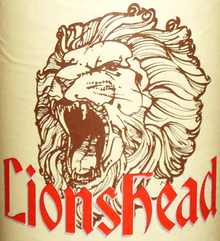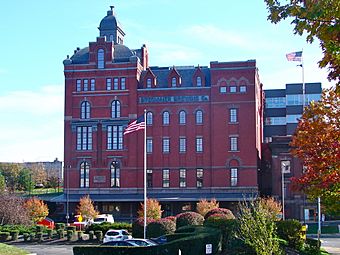Lion Brewery, Inc. facts for kids
 |
|||||||||||||||
| Location | Wilkes-Barre, PA, USA | ||||||||||||||
|---|---|---|---|---|---|---|---|---|---|---|---|---|---|---|---|
| Coordinates | 41°15′20″N 75°51′28″W / 41.25556°N 75.85778°W | ||||||||||||||
| Opened | 1905 as Luzerne County Brewing Company | ||||||||||||||
| Annual production volume | 55,000 US beer barrels (65,000 hL) of Lionshead | ||||||||||||||
| Owned by | Privately Owned | ||||||||||||||
| Active beers | |||||||||||||||
|
|||||||||||||||
| Seasonal beers | |||||||||||||||
|
|||||||||||||||
Lion Brewery, Inc. is one of the oldest companies still making drinks in Pennsylvania. It is located in Wilkes-Barre. The company sells its drinks in Pennsylvania and nearby states.
Contents
History of the Lion Brewery
Starting Years: 1905 to 1933
The Lion Brewery started in 1905 as the Luzerne County Brewing Company. They built a large brick building in Wilkes-Barre. The company bought the land for one dollar. They promised to make a lot of drinks in the first year. If they did not, the land would go back to the seller.
The brewery opened on May 25, 1906. It was made to produce special kinds of drinks. They made products under the name Edelbrau.
In 1908, the Luzerne County Brewing Company faced financial difficulties. It continued to operate under a manager. In 1911, the company changed its name to Lion Brewing Company. By 1912, they began selling Lion Beer.
Around 1919, a time called Prohibition began. During this time, making regular alcoholic drinks was illegal. The Lion Brewing Company started making "near-beers," which had very little alcohol. The company struggled to stay in business. In 1928, it was closed for a while.
The Smulowitz Family Era: 1933 to 1993
The brewery stayed closed until 1933. That year, a family named Smulowitz bought it. They owned the brewery for the next 60 years. When they reopened, the company could make a lot of drinks each year.
At first, they sold drinks as Lion Beer. In 1936, they changed the name to Gibbons beer. This was to avoid confusion with other brands. Gibbons became their main product for many years.
The Lion Brewing Company changed a lot under the Smulowitz family. In the 1940s, they started making lighter drinks. This was because people's tastes were changing. In 1957, William Smulowitz joined the company. He became president in 1969 and ran it until 1993.
In 1967, The Lion bought the recipes from Bartels Brewing Company. This company was located nearby and had closed. A bigger purchase happened in 1974. The Lion bought the recipes from Stegmaier Brewing Company. Stegmaier had been a much larger and older brewery. Stegmaier Gold Medal became The Lion's best-selling product.
In 1983, Lionshead beer was introduced. It is now the main product of the brewery.
The 1980s were a time of new ideas for The Lion. In 1981, they started making a non-alcoholic malt drink for Goya Foods. They also began making malt-based wine coolers in 1986. In 1987, they started making natural sodas.
Also in 1987, The Lion began making drinks for other companies. This is called "contract brewing." Their first contract drink was Manhattan Gold. Since then, they have made many drinks for other businesses.
Recent Events: Since 1993
In 1993, the Smulowitz family sold the Lion Brewery. A group called Quincy Partners bought it. In 1996, Quincy Partners made the company public. This meant people could buy shares of the company on the stock market.
In the 1990s, the brewery introduced a line of special drinks called Brewery Hill. The head brewmaster, Leo Orlandini, was named "Brewmaster of the Year" in 1999.
In 1999, Chuck Lawson led a group that bought the Lion Brewery. The company became privately owned again. In 2002, the Brewery Hill drinks were renamed Pocono.
The Lion Brewery held its first Oktoberfest celebration in 2005. This festival helps people learn about the brewery and German culture. Visitors can learn how drinks are made and enjoy food. Stegmaier Oktoberfest was made as the official drink for the festival. The festival includes tours, live music, games, and fireworks.
In 2007, Chuck Lawson and Pat Belardi sold the brewery to new investors. These investors continued to run the company as a private business.
In 2009, the brewery stopped using 16oz returnable bottles. This was to make space for a new canning line. The Gibbons and Bartels brands were also stopped.
Between 2007 and 2017, the Lion Brewery spent $20 million to update its equipment. They added new machines for labeling and packaging. They also improved their quality control. This included a special lab and scientists to check the products.
At the end of 2019, a company called Encore Consumer Capital bought the Lion Brewery.
Current Products
Lionshead
Lionshead is a popular product introduced in 1983. It is made with American malts, corn, and hops. You can mostly find it in Pennsylvania. The bottle caps have fun rebus puzzles on them. These puzzles were first created by another company. The top of the cap has a gold lion's paw and the words "claw off." There is also a Lionshead Light version. It is now available in cans too.
Stegmaier
The Stegmaier Brewery was started in Wilkes-Barre in 1857. It was founded by Charles Stegmaier from Germany. He learned to make drinks when he was 15. He moved to the United States in 1849. In 1857, he opened a small brewery. As his business grew, he built a larger brewery in 1863.
Charles Stegmaier's products became known for their great quality. His brewery grew very large. In 1894, a new six-story building was built. In 1897, the company became Stegmaier Brewing Company. This helped them expand even more.
Charles Stegmaier was a respected person in the community. He was fair and kind to his employees. He was also generous to those in need.
The Stegmaier Brewery was the biggest brewery in northeast Pennsylvania for many years. Stegmaier products won 8 gold medals in Europe between 1911 and 1913. This made its reputation even stronger. Stegmaier survived Prohibition by making low-alcohol drinks.
In 1974, the Stegmaier brewery closed. The Lion Brewery bought its recipes and names. The Lion hired 50 former Stegmaier employees. They made sure that Stegmaier products were made the same way as before.
As of 2019, Stegmaier products are sold in northeastern Pennsylvania.
Stegmaier products include:
- Stegmaier Gold Medal - This product won 8 gold medals in Europe. It became the main product of the Stegmaier Brewing Company. After The Lion bought the brand, it became The Lion's best-selling product.
- Stegmaier IPA - This was introduced in 2005. It celebrated the Lion Brewery's 100th anniversary.
Seasonal Stegmaier products include Porter, Pumpkin Ale, Oktoberfest, and Winter Warmer.
- Stegmaier Porter was first made by Charles Stegmaier a long time ago. Porter drinks started in England. They became popular in America. Stegmaier was one of the few breweries that kept making porters regularly. They helped keep this type of drink alive. Stegmaier Porter won a Gold Medal in 1997.
- Liebotschaner Cream Ale. This product was first made by Charles Stegmaier before 1886. It was brought back in 1962. It was made with special ingredients. In 1975, after The Lion bought the brand, Liebotschaner was brought back again. It won Gold Medals in 1994, 1995, and 1999. As of 2019, it is only available on tap.
Contract Brewing
The Lion Brewery also makes drinks for other companies. This is called contract brewing. They make products for brands like Pabst Brewing Company.
Past Products
Gibbons
The Gibbons brand started in 1936. It was named after Charles A. Gibbons, an early leader of the company. For many years, the brewery made Gibbons products. Gibbons was the main product until 1974. Gibbons products were made until November 2009. That is when the brewery stopped using 16oz returnable bottles.
Bartels
In 1967, The Lion bought the recipes from Bartels Brewing Company. Bartels was founded in 1889. Bartels was a darker product. Like Gibbons, Bartels was stopped in November 2009.
Brewery Capabilities
The Lion Brewery has modern equipment. They can package drinks in many ways:
- They can fill large kegs.
- They can fill 7, 9.3, 12, and 16 oz bottles. These can be in 4-packs, 6-packs, or 24-count boxes.
- They can fill any size can with a 202 lid. They can package cans in 4-packs up to 24-packs.
- They have equipment to filter and clean drinks.
- They can grow special yeasts for different types of drinks.
- Their building is very large, about 75,000 square feet (7,000 m2). It has many large tanks for storing and fermenting drinks.
The Stegmaier Building
|
Stegmaier Brewery
|
|
 |
|
| Lua error in Module:Location_map at line 420: attempt to index field 'wikibase' (a nil value). | |
| Location | Roughly bounded by Coal, Welles, Market, Lincoln and Baltimore Sts., Wilkes-Barre, Pennsylvania |
|---|---|
| Area | 4.6 acres (1.9 ha) |
| Built | 1894 |
| Architect | Wagner & Caper; Frey, McCormich & French |
| Architectural style | Romanesque |
| NRHP reference No. | 79002292 |
| Added to NRHP | May 30, 1979 |
The Stegmaier Brewery building in Wilkes-Barre, Pennsylvania, was finished in 1894. It was the main office for Stegmaier Brewing Co. until it closed in 1974. The Lion Brewery bought Stegmaier's product names, but not the building itself. However, the old building has been shown on some Stegmaier packaging.
Today, the old brewery building is called the Stegmaier Federal Building. It is used as office space for government workers. This keeps federal offices in downtown Wilkes-Barre.
The building also houses the Wilkes-Barre Information Systems Support Center. This is a technology center for the United States Postal Service. The Internal Revenue Service also has an office there.


